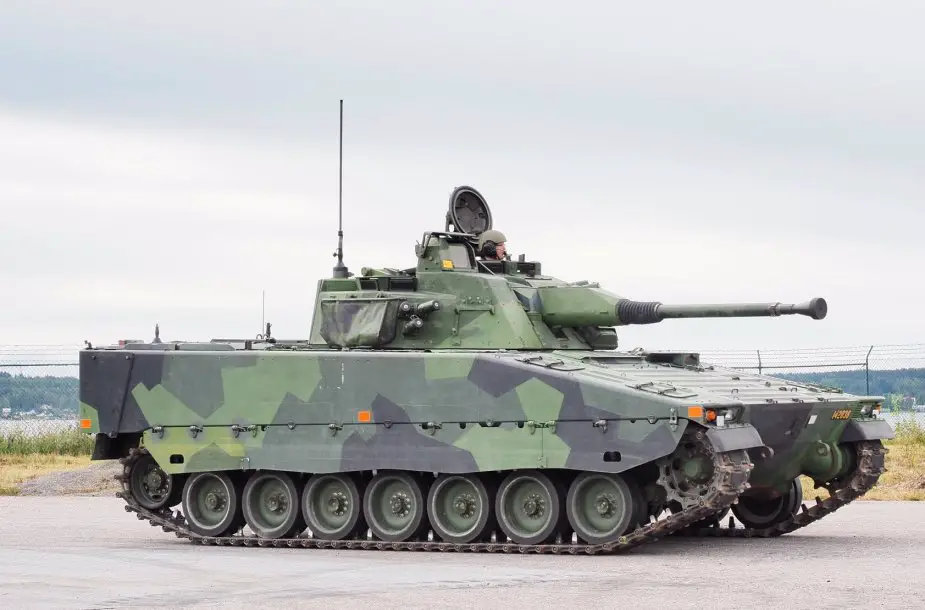Breaking news
Swedish army receives 100th CV90 Combat Vehicle.
On Aug.27, the Swedish army received its 100th Combat Vehicle 90 (CV90, in Swedish: Stridsfordon 90, Strf90). CV90 is a family of Swedish tracked combat vehicles designed by Sweden's Defense Materiel Administration (Försvarets Materielverk, FMV), Hägglunds and Bofors during the mid-1980s and early 1990s and entered service in Sweden in the mid-90s.
Follow Army Recognition on Google News at this link

Reception of the 100th CV90 by the Swedish army (Picture source: Twitter account of Mikael Frisell)
The CV90 platform design has continuously evolved in steps from Mk.0 to current Mk.IV with advances in technology and in response to changing battlefield requirements. The Swedish version of the main infantry fighting vehicle is fitted with a turret from Bofors that is equipped with a 40 mm Bofors autocannon. Export versions are fitted with Hägglunds E-series turrets, armed with either a 30 mm or a 35 mm Bushmaster autocannon.
Developed specifically for the Nordic sub-arctic climate, the vehicle has very good mobility in snow and wetlands while carrying and supporting six to eight fully equipped dismount soldiers. Other variants include Forward Observation, Command and control, anti-aircraft, armoured recovery vehicle, electronic warfare and so forth. The CV90 and Hägglunds E-series turrets have been under continuous development with more than 4 million hours invested and are still produced with modern protection, armament and network enabled solutions. Currently, 1,280 vehicles in 15 variants are in service with seven user nations, four of which are NATO members, under BAE Systems Hägglunds AB.
The CV90 has undergone four mark shifts to meet different customer requirements, focused on capability enhancements.
CV90 Mk 0
The first delivered CV90 was for Sweden. It was armed with the Bofors 40/L70 cannon in a 2-man turret. The vehicle had a conventional electrical system and was fitted for but not with appliqué armour systems. The Swedish Army ordered five variants of the CV90. The requirements expressed by the Swedish FMV on signature management were extremely challenging and led to a lot of new design features that have been inherited by all subsequent generations (Mk 0-III). FMV also prioritized the requirements to provide the best possible design to fulfil user needs. Furthermore, the CV90 was also built for high reliability and ease-of-maintenance using only standard on-board tools and conscripts to maintain and operate.
CV90 Mk I
The next variant of CV90 is known as the Mk I and was delivered to Norway. CV90 Mk I won the Norwegian competition for a new IFV against other contemporary IFVs, such as Bradley, Warrior and Pizarro/ULAN. The Mk I variant of the CV90 had a newly designed 2-man 30 mm turret evolved from the 25 mm turret. CV90 Mk I was the first IFV with a high hit probability performance during suppression fire modes, both while the vehicle is on the move and against air targets. The CV90 Mk I incorporated several improvements compared to the original Swedish CV90. Trials on mobility, reliability, lethality, fightability, ergonomics, durability and survivability were performed during the trials phase for these vehicles with good results for CV90 Mk I.
CV90 Mk II
The CV90 Mk I was the base for the next development step, CV90 Mk II. The CV90 Mk II was produced in three variants, CV9030 CH (Switzerland) IFV & COM, and CV9030 FIN (Finland) IFV. Both contracts were won in competition with other IFVs. The difference between the two variants is mainly the size of the hull. The Swiss variant is 100 mm higher over the front part of the hull and an additional 70 mm over the combat compartment at the rear. The principal difference between the Mk I and Mk II is that the Mk II was partly digitized and provided with built-in Health & Unit Monitoring System (HUMS) together with interactive manuals and instructions. CV90 Mk II standard armament is Mk44 Bushmaster II autocannon.
CV90 Mk III
The Mk III variant of the CV90 is a further development of the CV90 Mk II. The areas that have undergone most development compared to Mk II are lethality, fightability, electronic architecture, survivability and mobility. The weapon system has been upgraded to a 35/50 mm Bushmaster III cannon with an integrated muzzle ammunition programmer and a number of different firing scenarios depending on target setup. The crew station design provides the gunner and commander with a continuous eye-on-target engagement feature (do not need to remove head from eye-piece to see and operate equipment).
The electronic architecture has been further upgraded for Mk III to be completely digitized. The mobility improvements, in the field of upgraded suspension and power to weight ratio, was performed to handle the increased gross vehicle weight. The improved survivability was mainly in the areas of mine protection and top attack. The horizontal protection has been designed in similar ways as to the other marks of CV90, i.e. appliqué systems. The first variant of the Mk III, the Mk III a, was delivered to The Netherlands and Denmark. The second, most modern Mk IIIb variant, was delivered to Norway.
CV90 Mk IV
CV90 MkIV is equipped with a new engine, active protection system, augmented reality system iFighting and its weight has increased from 35 to 37 tons, with space for two tons of additional payload.


























